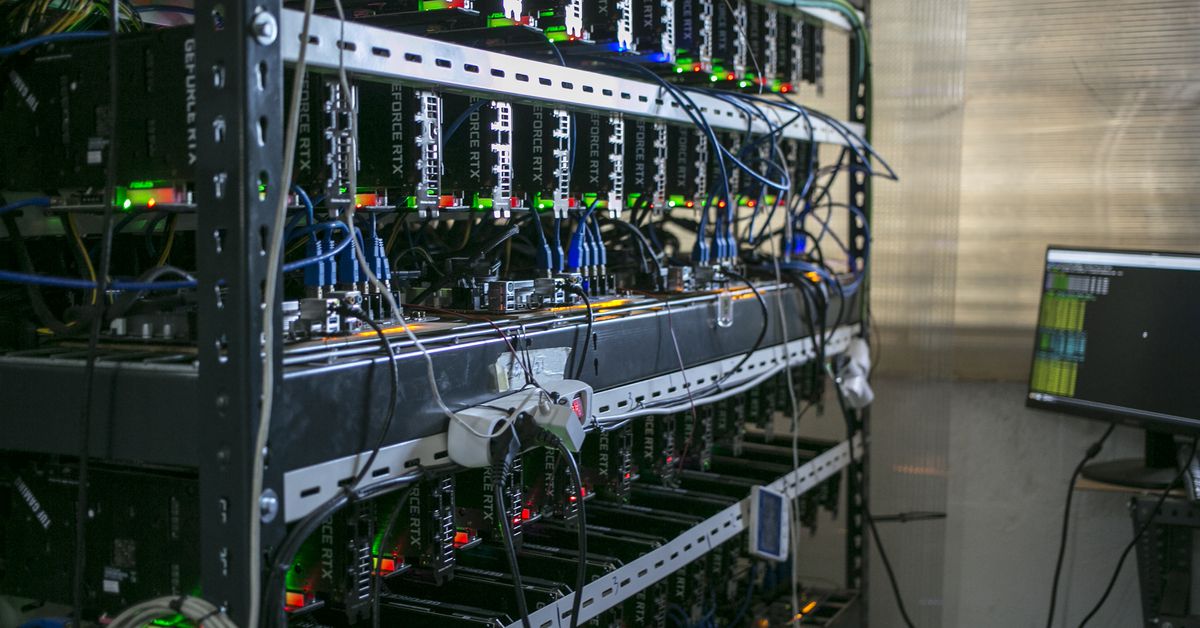
Ethereum just set The Merge in motion — and the stakes are huge for the planet. The Merge is arguably one of the most anticipated events yet in cryptocurrency history, when the Ethereum blockchain will switch from a disturbingly energy-hungry method of validating transactions to a new strategy that uses a fraction of the electricity as the network gobbled up before.
The transition is supposed to slash Ethereum’s energy consumption by a whopping 99.95 percent. That’s a seriously big deal since, just last week, the cryptocurrency network was estimated to use as much electricity annually as the country of Bangladesh. All that energy, of course, comes with a lot of carbon dioxide pollution that’s exacerbating climate change. Ethereum’s native token, Ether, is the world’s second-largest cryptocurrency by market capitalization after Bitcoin.
How is nearly all the pollution Ethereum was previously pumping out supposed to virtually disappear? It’s complicated, so let’s break it down as simply as we can.
What is The Merge?
It boils down to a dramatic change in how transactions are recorded on the Ethereum blockchain. A blockchain is a record of transactions that’s maintained communally rather than by a single institution like a bank (check out The Verge’s handy blockchain explainer here). “Blocks” of transaction records are added to the chain by many different players, which is why blockchains are often described as “distributed ledgers.”
With so many players — also known as nodes — involved, blockchains need a security system to make sure no one screws with or takes over the ledger. Ethereum’s old version of a security system happens to be intentionally energy-intensive, so the network is switching to a new one through The Merge.
What made Ethereum so polluting in the first place?
Energy inefficiency was built into the network from the start, thanks to that old “security system” Ethereum ran on called proof of work. With proof of work, “miners” validate blocks of new transactions by solving computational puzzles. This is supposed to avert double-spending, and miners earn new tokens in return. To prevent too many new tokens from flooding the market, the puzzle solving gets harder over time — requiring more energy.
The cost of solving those puzzles, in equipment and electricity bills, is meant to make it harder for any one entity to gain too much influence over the ledger. If that happened, it would defeat the purpose of having a decentralized financial system in the first place. Plus, it comes with the risk of a bully coming along and manipulating the ledger for their own gain.
With proof of work, energy consumption and pollution balloon because miners can earn more tokens by adding more powerful computers to their operations. Crypto “mines” are essentially giant data farms filled with hardware running around the clock to solve puzzles. When miners set up shop in a new place, they typically drive up electricity bills for nearby communities. Plus, they leave behind e-waste from the hardware they use to solve those puzzles.
Besides Ethereum, the other major cryptocurrency infamous for problems associated with proof of work is Bitcoin. Bitcoin miners’ search for abundant, affordable energy to power their operations has breathed new life into fossil fuel power plants that were dying away. Those plants then spew more pollution into the air.
Policymakers are grappling with how to manage all those consequences stemming from proof of work. State legislators in New York, which became a hub for crypto mining after China cracked down on it in 2021, passed a moratorium this year on cryptocurrency mining operations that use proof of work. Nationally, Democratic lawmakers have probed crypto mining companies about their energy use and have asked federal regulators to establish new rules for crypto mining in the US.
There’s even a campaign called Change the Code, Not the Climate led by the nonprofits Greenpeace USA and Environmental Working Group that’s pushing the Bitcoin network to follow Ethereum’s move.
Is The Merge going to fix Ethereum’s environmental problems?
The Merge, if all goes well, is expected to shrink Ethereum’s environmental footprint significantly. To leave proof of work behind, Ethereum is transitioning to a new process for validating transactions called proof of stake. This method gets rid of all that pesky puzzle solving altogether — eliminating the need for powerful hardware and massive amounts of electricity to keep the blockchain going.
Instead of using enormous energy costs as a deterrent to bad behavior, proof of stake requires validators to lock up crypto tokens as collateral. That way, the validators have a stake in keeping the ledger accurate. If anyone else on the network finds that someone has added faulty blocks to the chain, the guilty party loses tokens they’ve staked. In Ethereum’s case, you need to stake 32 ETH tokens to get started as a validator. With each token worth around $1,600 today — bad actors risk losing a hefty amount of cash.
Validators will still be rewarded with new tokens for doing the job right. Staking tokens enters them into a new sort of lottery to verify blocks of transactions and receive that reward. An algorithm randomly picks which validators, among those who have staked tokens, to create the next block in the chain. To increase the odds of being the one chosen to add the block, you need more tokens — not more computing power.
As a result, a successful transition to proof of stake is expected to slash Ethereum’s energy use by at least 99 percent. The Ethereum Foundation put the number at roughly 99.95 percent. There’s about a percent of wiggle room based on how much energy is used after The Merge by the computers still needed to store data and verify transactions. Validators will still want to keep computers running 24/7, but they won’t be using up as much juice to solve those pesky puzzles.
Overall, we’re talking about serious energy savings. It’s equivalent to about as much electricity as a quarter of the world’s data centers use annually, according to Alex de Vries, a researcher who runs the website Digiconomist that tracks Bitcoin and Ethereum energy use. de Vries expects that dramatic drop in energy use to slash 30 to 35 million metric tons of carbon dioxide emissions a year if The Merge is successful.
How is this all going to go down?
In a nutshell, all the computers that run the blockchain’s software need to update that software to the newest version that uses proof of stake. Of course, that’s easier said than done when you’ve got hundreds of thousands of nodes in the network. But we’ll get back to that later.
To get to this point, researchers developed a new “Beacon Chain” that uses proof of stake that’s been running parallel to Ethereum’s main proof of work blockchain. The old blockchain should ultimately merge with the Beacon Chain, getting rid of proof of work. The Merge will take place in two phases, and the first one just kicked off after years of delays. The Bellatrix upgrade went live today, which will get the Beacon chain ready for the final transition in the next few weeks. In the second phase, the Paris upgrade, crypto mining for Ethereum that uses proof of work, should finally come to a stop.
What could go wrong?
The big worry is that too many miners will mutiny and decide to stick with proof of work. They’ve already invested in setting up their crypto mining farms, and many will likely be hard-pressed to let go of their hardware. There are a couple different ways this mutiny might play out.
If enough of them decide to forego the software update, then they could keep Ethereum’s old proof of work blockchain alive. There’s already a push by some miners to do this. If that blockchain persists, so will the pollution it produces. How much pollution depends again on how many miners mutiny and how much value the tokens on that zombie chain, called a “fork,” retain. They’ll essentially only be able to sustain as much mining as the value of the token allows since they have to be able to pay off their electricity bills and still turn a profit.
Or, the miners might choose to find another, more established proof-of-work blockchain. The Ethereum network has already split in two in the past in response to a hack in 2016, which created two blockchains: Ethereum and Ethereum Classic (both use proof of work). Now it looks like some Ethereum miners are already moving over to Classic in response to The Merge, sticking to their energy-hungry ways.
There are also security risks for Ethereum if there ultimately aren’t enough validators participating on the new proof of stake blockchain. “If you have very, very few validators, then it’s easy to attack the network. So we want to make sure that the participation rate of hundreds of thousands of validators is close to 99 percent,” says Leonardo Bautista Gomez, founder of the blockchain research group Miga Labs, who has also worked with the Ethereum Foundation to help develop the Beacon chain.
To Bautista Gomez, The Merge “shows that even though it may be technically difficult to implement, we make the effort to do this because we are conscious of our environmental responsibilities.”
But even if everything goes smoothly with The Merge, blockchains are still inherently inefficient, says de Vries, who also works as a data scientist for De Nederlandsche Bank. By nature of being a distributed database, data is replicated across many devices, and that uses more energy. Still, de Vries acknowledges that proof of stake is orders of magnitude less wasteful than proof of work.
The Merge is tentatively expected to be done by the end of the month. Then we’ll see how successful the transition was and what new challenges might have arisen.


/cdn.vox-cdn.com/uploads/chorus_asset/file/25383554/STK467_AI_MUSIC_CVirginia_B.jpg)



